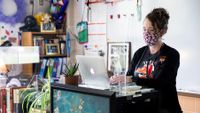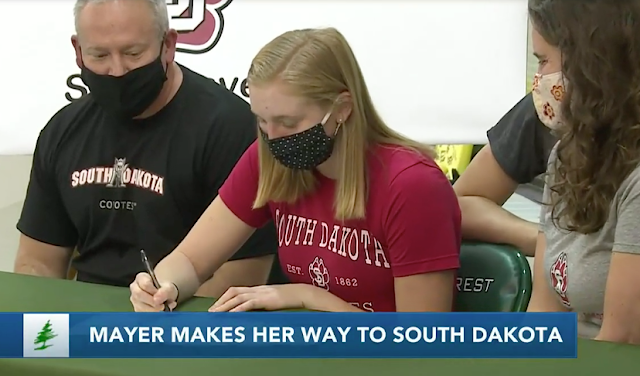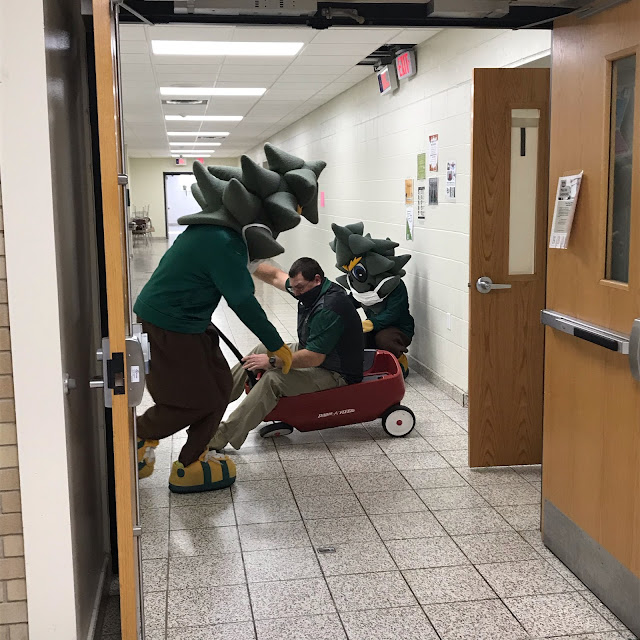D.C. Everest Senior High School Staff Update
Weekly Happenings
Getting a true sense of students’ learning and discouraging cheating is tough when some students are in the room and some are at home, but it can be done.
By Kasey Short
November 23, 2020

Rachel Wisniewski / Alamy
Since August, I’ve taught in a hybrid model where I synchronously teach students in person and remotely, including some students who are remote every day. This arrangement has created significant challenges in terms of assessment.
When students are at home, I can’t walk around and spot-check their work to ensure that they’re on the right track and understand my directions. Some students feel uncomfortable asking questions in front of their classmates no matter the environment, and when they’re remote, it’s not easy to find private opportunities when they can ask questions during an assessment.
Remote learning also increases the potential for students to make dishonest choices. Those who would never have considered cheating before might now be home, getting texts or calls from friends asking for help; they also have access to their phone and other devices.
Through trial and error, I’ve landed on strategies for assessment that work in this radically different and complex teaching environment.
FORMATIVE ASSESSMENT
I’ve designed discussions that get to the heart of what we are learning and invite every student to engage so that I can check their understanding and progress. For example, I provide students with questions the day before the discussion to review so they can write their responses in advance. Then, throughout the live discussion, I alternate between engaging with students in person and students who are remote so that they’re all equally involved.
I keep a running list to ensure that I’m consistently addressing all students. I solicit additional participation from students on their remote days because I am not able to visually check in on their progress and because it’s easier for them to disengage. Remote students have opportunities to answer verbally, in the chat feature or using another digital platform. If the question requires only a few words to answer, I may ask all the remote students to type their response in the chat. To involve both the remote and in-person students, I use Google Jamboard to gather their quick written responses.
I also formatively assess progress on long-term writing assignments by having students share their work via Google Docs; I would normally walk around and read student assignments with them and provide individual feedback, but with Google Docs, I can do that for students in both settings.
To formatively check students’ progress and allow them to check their own understanding, I use Google Jamboard and Padlet, which provide opportunities for students to share open-ended responses, links, and photos while collaborating with each other; these tools also provide me with information about their progress and understanding. With Gimkit, Quizlet Live, and Socrative, students can complete multiple choice and true/false questions and quickly see where they stand; these tools also provide immediate feedback that’s helpful for them and for me.
Finally, in terms of formative assessment, one-on-one check-ins when students are in the physical classroom help me to stay up-to-date on their progress, and if they are exclusively learning remotely, I send emails at least every other week and check in with Google Classroom or Google Meet.
STUDENT SELF-ASSESSMENT ACTIVITIES
Self-assessment helps students to develop independence and ownership of their learning, which builds confidence and a sense of their strengths and areas for growth. That self-awareness is even more important in a hybrid model, where students don’t have as many opportunities to informally check in with their teacher and get quick feedback.
Students complete one or more activities about a specific concept to assess their own learning. Here are some of the prompts I use:
- Explain the concept to someone else.
- Make a list of the most important aspects of _____.
- Explain how _____ connects to _____.
- Draw a picture/map/graph/diagram that explains _____.
- Explain information to yourself in the mirror.
In the hybrid model, I have designed all summative assessments so that students apply and analyze content; students use the text as a reference when completing the assignment. I avoid asking questions that I know have answers that are on the internet or could be easily shared with a friend. For example, if I’m asking about a novel they’re reading, I don’t ask about the plot but rather prompt them to make connections, explain themes, or make comparisons to another book. This approach reduces the opportunity for dishonesty and gives students a chance to demonstrate what they have learned.
All major assessments are given over two days so that students can ask questions in person and work within the structure of a school environment; students who are remote-only can ask questions in advance via Google Meet, in chat, or via email.
With two days, students have ample time to give the assessment their best effort, as our class periods are shorter this year and tasks take longer when students access materials and turn in assessments online. (Anecdotally, I have noticed that on average, students are turning in more detailed and higher quality assignments than ever before.)
Students can showcase their knowledge in different ways if the format of assessments changes throughout the year and if they have agency through choice and voice. When I mix things up, I can also assess which formats are optimal for hybrid instruction.
Extended response: I provide six open-ended questions, and students choose three to answer with a thoughtful response using details and evidence from the text to support their ideas.
Hexagonal thinking: I provide students with 15–25 words about a specific topic. They write those words on hexagons and organize them so that all the sides connect in meaningful ways. Then students choose one central hexagon and explain all six connections to that one hexagon.
Video: Students create a video response to answer their chosen question(s) and present evidence to support their ideas. This format increases engagement and provides an opportunity for students with strong verbal but weak writing skills to shine. It also allows me to hear them talk through their thinking, which I don’t have as many opportunities to do in the hybrid model.
I provide all students with specific and targeted feedback on their performance via Google Classroom comments, personal conversations, or email. After summative assessments, I designate time within my class for them to review digital feedback so that it does not get lost in their email and so that they can ask me questions. Post-assessment student reflection questions include the following:
- Did you feel prepared for the assessment?
- What strategies did you use to prepare for the assessment?
- What would you do the same and what would you improve?
- Do you think the assessment gave you an opportunity to showcase your knowledge of the topic?
Week Ahead
ELT - Transeo Rollout - On Wednesday, December 2nd (Cohort A) and Thursday, December 3rd, (Cohort B) we will be running an ELT Schedule to rollout Redefining Ready and the Transeo Platform. Students should be reporting to their ELT Homeroom located after their 10 class periods as an activity on their Infinite Campus Schedule. Teachers and students will receive an email from Rose Matthiae on Monday, November 30th with the details to include the video, Transeo login information, and the student assignment to be completed during this ELT.ELT Student Rosters Completed in IC - The ELT student rosters are completed in IC as an activity. Please print out your ELT roster for Wednesday and Thursday to see who your students are. During your classes on Monday and Tuesday, please remind your students to look at their IC to find out where they should be going after period 3 on Wednesday and Thursday. Please also use your roster to keep track of attendance. If you need help running your roster or have way too many kids on a specific cohort day, please let Dawn Seehafer know.
Students need to bring their iPad to ELT on Wednesday and Thursday - Please remind all of your students throughout the day. Thanks










































